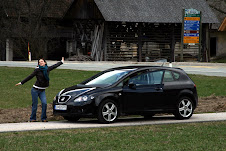We hit the road and drove almost to Graz, when we saw signs of the Rogner Bad – Blumau (www.blumau.com). Although neither of us recognized the name, the design elements of the sign were clearly that of Hundertwasser, our beloved artist and architect. So, as good travelers in any road trip, we got off the highway and visited.
The wellness spa resort with mineral springs exhibits Hundertwasser’s dream of how society should co-exist with nature. All lines are drawn from nature; they are not flat, not even the floors, they are organic and undulating from ceiling to what would be a corner. Each space is also exploited to its fullest extent to provide a growing platform for living things. Hundertwasser was seen as extreme and a fanatic during his life. But, as with many great thinkers, his thoughts are revered at present and many of his projects have flourished after his death.
Brano and I have visited his museum. His art adorns our walls and finally it was like a dream to walk through its realization. I felt awed.
The wellness spa resort with mineral springs exhibits Hundertwasser’s dream of how society should co-exist with nature. All lines are drawn from nature; they are not flat, not even the floors, they are organic and undulating from ceiling to what would be a corner. Each space is also exploited to its fullest extent to provide a growing platform for living things. Hundertwasser was seen as extreme and a fanatic during his life. But, as with many great thinkers, his thoughts are revered at present and many of his projects have flourished after his death.
Brano and I have visited his museum. His art adorns our walls and finally it was like a dream to walk through its realization. I felt awed.
(The captions are all quotes from Hudertwasser.)
 "When we dream alone it is only a dream, but when many dream together it is the beginning of a new reality."
"When we dream alone it is only a dream, but when many dream together it is the beginning of a new reality." "The architects have lost responsibility for their doing. They are building criminal structures unworthy for men to live in, insane illusions become relaity in ferro cement. They are building concentration-camp-like cells where man's soul perishes."
"The architects have lost responsibility for their doing. They are building criminal structures unworthy for men to live in, insane illusions become relaity in ferro cement. They are building concentration-camp-like cells where man's soul perishes." "A person in a rented apartment must be able to lean out of his window and scrape off the masonry within arm’s reach. And he must be allowed to take a long brush and paint everything outside within arm’s reach. So that it will be visible from afar to everyone in the street that someone lives there who is different from the imprisoned, enslaved, standardised man who lives next door."
"A person in a rented apartment must be able to lean out of his window and scrape off the masonry within arm’s reach. And he must be allowed to take a long brush and paint everything outside within arm’s reach. So that it will be visible from afar to everyone in the street that someone lives there who is different from the imprisoned, enslaved, standardised man who lives next door." "The horizontal belongs to nature, the vertical belongs to man. Where snow and rain fall vegetation should grow in the cities."
"The horizontal belongs to nature, the vertical belongs to man. Where snow and rain fall vegetation should grow in the cities." "What we urgently need are barriers of beauty; these barriers of beauty consist of uncontrolled irregularities. Paradises can only be made with our own hands, with our own creativity in harmony with the free creativity of nature."
"What we urgently need are barriers of beauty; these barriers of beauty consist of uncontrolled irregularities. Paradises can only be made with our own hands, with our own creativity in harmony with the free creativity of nature." "Art must meet man's and nature's pace. Art must respect nature and the laws of nature. Art must respect man and man's aspiration for true and durable values. Art must again be a bridge between creativity of nature and creativity of man. Art must regain its universal function for all and not be just a fashionable business for insiders"
"Art must meet man's and nature's pace. Art must respect nature and the laws of nature. Art must respect man and man's aspiration for true and durable values. Art must again be a bridge between creativity of nature and creativity of man. Art must regain its universal function for all and not be just a fashionable business for insiders"














































